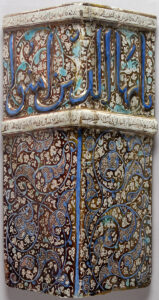
LNS 219 C a,b
شكلت بالقالب، وأضيف إليها طلاء تزجيح أبيض معتم، ورسم فوق التزجيح بلون أزرق فيروزي وكوبالتي، وبألوان البريق المعدني.
يعتبر السيراميك من أقدم المواد التي تم استخدامها في الصناعات والحرف، حيث يعود تاريخها إلى العصر الحجري القديم، أي منذ أكثر من ثلاثين ألف عام. تضم مجموعة الصباح الآثارية فنيًات متنوعة من السيراميك، والتي تركزت على تجميع هذه التحف الفنية والتي تم تشكيلها بطرق مختلفة من قبل الحرفيين آنذاك، والتي بدأت منذ العصور المبكرة وحتى القرن التاسع عشر الميلادي.
التشكيلة التالية تضم تحفاً فنية مصنوعة من السيراميك منها: وعاء من الخزف تظهر عليه صور ثيران وظباء من وادي السند، تعود الى 5 آلاف سنة، بالاضافة إلى وعاء لامع والذي يظهر لمعاناً معدنياً ناتجاً عن تأكسد المعدن عندما تم تسخينه للمرة الثانية في فرن منخفض الأكسجين، وتم استخدام تقنية الزخرفة هذه لأول مرة على السيراميك في العراق في القرن التاسع الميلادي، والتي انتشرت في نطاق واسع على مدى قرن من الزمان.
أدى تطوير الأواني المصنوعة من العجينة المركبة في القرنين الحادي والثاني عشر الميلاديين إلى تزويد خزافي العصر الإسلامي بمادة ناصعة البياض تحاكي نوعية الخزف المصنوع في الصين، والذي تم اعتباره من أفخم وأغلى أنواع السيراميك آنذاك. تنوعت الخزفيات والفنيات المصنوعة من السيراميك والتي تعود إلى العصر الإسلامي بأحجامها المختلفة، فمنها كبيرة الحجم ومنها الصغيرة، وتشمل الجرات والأوعية التي تم صنعها في إيران وسوريا وتركيا.
كان الغرض من استخدام بلاطات السيراميك متعددة الألوان، هو تزيين المباني، كما كان شائعاً في الشرق الأدنى، والتي تم اعتبارها كأهم المواد في صناعة الخزف إبان العصر الإسلامي، حيث تم تطوير استخدام السيراميك واستحداث طرق جديدة في الصناعة على نطاق واسع فيما بعد.

شكلت بالقالب، وأضيف إليها طلاء تزجيح أبيض معتم، ورسم فوق التزجيح بلون أزرق فيروزي وكوبالتي، وبألوان البريق المعدني.
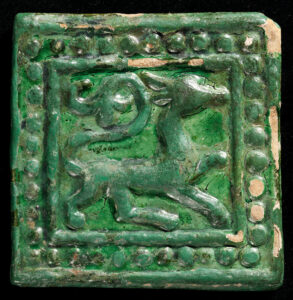
ثلاث بلاطات من الفخار، تصور عنزات متقاربة الشبه، تنتهي ذيولها بأنصاف مراوح نخيلية ملتوية.
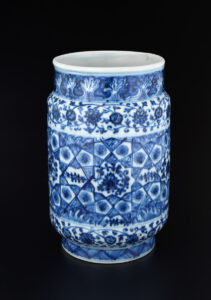
جَّرة من البورسلان، أنتجت للسوق المحلي الصيني أو لسوق خارجي لبلاد المسلمين، يحيط بالبدن من الوسط شريط زخرفي عريض عليه
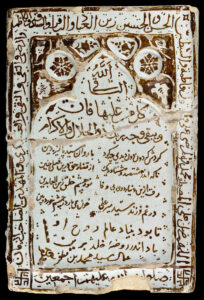
شاهد قبر خزفي، صنع من عجينة مركبة، نفذت عليه كتابات بألوان البريق المعدني، بخط النسخ وخط النستعليق، منها: “الله الباقي”،
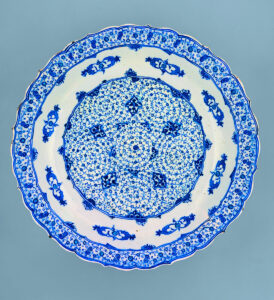
طبق من الخزف.
صنع من عجينة مركبة، يتوسطه تكوين يتألف من ستة أفرع دائرية لولبية، مورقة ومزهرة، ومن خمس
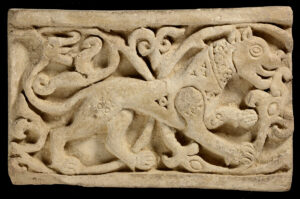
بلاطة من فخار غير مزجج (ربما كانت جزًءا من إفريز زخرفي)، نحت عليها أسد بين أغصان لولبية، ويتحول ذيله والأغصان
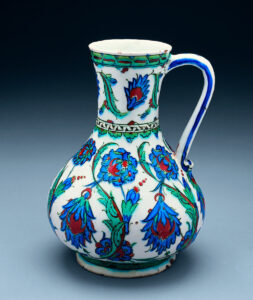
دورق خزفي من خامة مركبة، تغطي البدن لفائف مورقة عمودية تحمل أزهار اللوتس، والعنق مزخرف بلفائف متصلة من أوراق وأزهار

لوحة من الفسيفساء صنعت من عجينة مركبة تم تركيبها فوق الجبس، عليها نقوش كتابية، تتضمن الآية 286 من سورة البقرة:
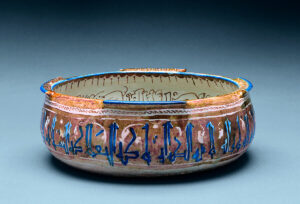
سلطانية من الخزف، شكلت من عجينة مركبة، وُرسم عليها بالأزرق وألوان البريق المعدني؛ في مركزها، صورة طيور وسط فروع ملتفة
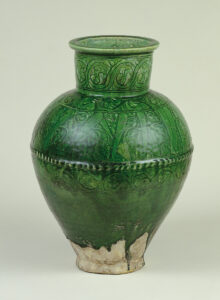
جَّرة من الخزف، ُصنعت من عجينة مركبة، توجد حول الكتف كتابات بخط الثلث وتمت زخرفته بالحفر البارز، تعِّبرعن طيب الأماني
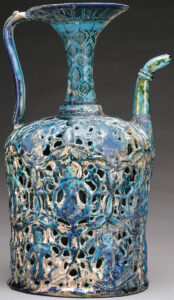
إبريق من الخزف، ذو بدن مركب، مزدوج السطح، نفذت على الطبقة الخارجية زخارف شبكية، تصور شخصيات ملكية تجلس في مقصورات
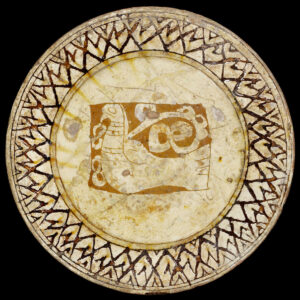
طبق من الفخار (يعرف بنمط مدينة غاروس)، عليه رسم يمامة وغصن، نفذ بأسلوب تجريدي محَّور.
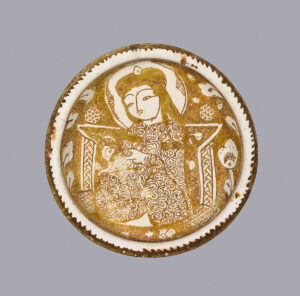
صينية من الخزف، صنعت من عجينة مركبة، ترتكز على ثلاث قوائم، رسم عليها بألوان البريق المعدني، أمير متوج تحيط به
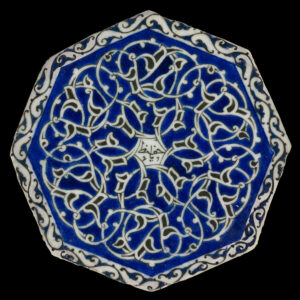
بلاط خزفي مصنوع من عجينة مركبة، من ضريح الخواجا ربيع، في مشهد (شمال شرقي بلاد فارس)، مزينة بأنصاف مرواح نخيلية
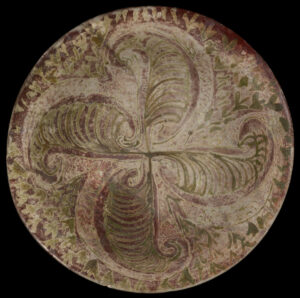
سلطانية من الفخار، رسمت عليها أنصاف مرواح نخيلية على شكل دوامة، بألوان البريق المعدني، الأحمر النحاسي والأخضر الزيتوني.
قد يعجبك أيضًا
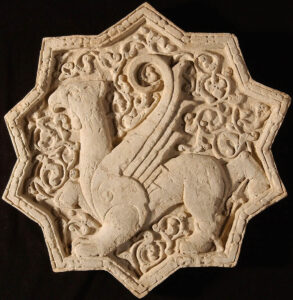
للحجر والجص تاريخ طويل في الفن والثقافات التي أصبحت فيما بعد تندرج تحت الحضارة الإسلامية، فقد تم استخدام الحجر في العصر البرونزي لصناعة أو نحت القرابين للحيوانات المقدسة والشياطين والآلهة وكانت الصخور رموزا تقديرية للمعتقد السائد انذاك.
ظل الحجر والجص
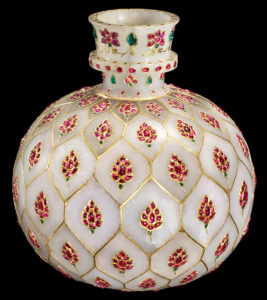
تحتوي مجموعة الصباح الآثارية على مجموعة لامثيل لها من المجوهرات والأحجار الكريمة، ولا تجسد مدى جمال القطع فقط، بل المهارات الجمالية والتقنية لأجيال من الحرفيين والفنانين.
إضافة لكونها المجموعة الأكبر والأكثر احتواءً على المجوهرات الإسلامية في العصور الوسطى على مستوى
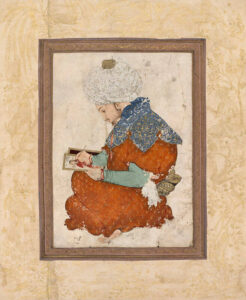
تحتوي مجموعة الصباح على عدد وفير من مخطوطات القرآن الكريم، والتي تضم صفحات مزدوجة لواحدة من أقدم المخطوطات القرآنية المعروفة، والتي تم نسخها في القرن الثاني بخط رأسي مميز يعرف باسم “الحجازي”، إضافة إلى مخطوطة كبيرة الحجم، مزينة بشكل رائع،